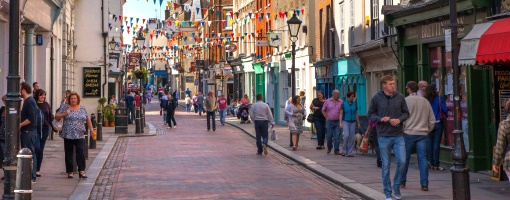Nick Brackenbury, the co-founder and CEO of NearSt, chats with Retail Systems about the retail startup which is using technology to transform the High Street shopping experience.
Can you give us a bit of background about NearSt? Who are you and what you do?
NearSt connects the products in High Street shops to people nearby with our hyperlocal search and shopping platform. Today we’re a technology, site and app where you can search millions of products on the shelves of thousands of High Street shops in London, with a rapidly growing number of these offering one-hour delivery and instant collection.
The company started after my co-founder, Max, had a literal light bulb moment. He was having some friends over for dinner when his light broke. His phone couldn’t tell him where the specific bulb he needed was stocked nearby, and so he spent over an hour visiting stores in the area trying to find it. After getting home he wondered how it was easier for him to find the light bulb online from a warehouse hundreds of kilometres away than find it in a store just a few hundred metres from his front door. And so, NearSt began.
Can you explain how your retail technology works?
Partially – we still keep the details behind closed doors. We’re powered by our own custom-built platform called NearLIVE, which took over a year to develop. It connects to the existing EPoS system in a store to extract very basic stock information, and then transforms this into rich product listings. When a customer places an order we check this very rapidly with the store for confirmation, who typically do so in just a few minutes. The real power of the technology is that retailers have to do almost nothing to use NearSt. There’s no extra hardware in-store or new software to install - NearLIVE works with what’s already in store. It’s an incredibly powerful and unique bit of technology that our engineering team have created.
You started out as a partner to bookshops. Do you currently work with other retailers and do you plan to expand your offering? Are there any partnerships with major brands in the pipeline?
We spent our first two years working exclusively with a fantastic set of partner bookshops in London to perfect the technology. The industry presents a unique inventory challenge, in that even a small bookshop has thousands of SKUs and typically just one unit of each in-stock, so getting to a high level of stock confidence is really a challenge. Using those learnings has made it possible for us to launch in six new retail verticals this summer, and we aim to be in fifteen by the end of the year. On major brand partnerships, watch this space…
What have been the challenges getting to this stage?
Retail is a very interesting but challenging industry. Only the biggest players have the budgets to invest in omnichannel and even then still struggle to compete with pure-play ecommerce sites. The biggest challenge we’ve faced is the diverse characteristics of retail. While there are a universal set of problems everyone is trying to solve, there is massive fragmentation with how everyone is going about it. Getting our heads around this was a real challenge, followed promptly by figuring out how to prioritise which areas to tackle first. We’ve made a lot of progress, but are still learning.
Is there anything you would do differently in hindsight?
I don’t think so – not because we got everything right, but because I think the only way you learn and get better is by making mistakes and getting things wrong. It’s a Silicon Valley cliché, but I really believe in the ‘fail-fast’ mentality. If I had to change anything I’d try and help our entire team get better at this earlier.
Do you think shopping habits have changed over the past few years, particularly with the introduction of new technologies, and how do you think they will change in years to come?
Massively! The ‘Uberification’ of the world has transformed so many industries. We now expect our phones to get us anything we need in just a few taps, whether that be a cab, meal, laundry or handyman. Retail is still conspicuously absent from this on-demand experience, to the industry’s loss and Amazon’s gain. Tap any product into the search bar on your phone, and count how many results you see in a High Street shop compared to an online shop. We see a future where retail plays a central role in this experience. I think to a teenager in three or four years’ time it will seem unthinkable that once-upon-a-time your smartphone didn’t know where every product was stocked nearby, and that we ordered everything from warehouses hundreds of kilometres away instead.
Latest News
-
Currys upgrades payment technology to enable AI-powered shopping experiences
-
Waitrose pledges new ‘market leading’ welfare standards for charcuterie
-
Ocado ends tech exclusivity agreement in ‘most markets’
-
Asda announces new group CIO
-
What’s next for retail in 2026?
-
The most read Retail Systems stories of 2025
Beyond Channels: Redefining retail with Unified Commerce
This Retail Systems fireside chat with Nikki Baird, Vice President, Strategy & Product at Aptos will explore how unified commerce strategies enable retailers to tear down these barriers and unlock new levels of operational agility and customer satisfaction.
The future of self-checkout: Building a system that works for consumers and retailers
In this webinar, industry leaders discussed what the future of self-checkout looks like and how retailers can make the technology work for everyone.
© 2024 Perspective Publishing Privacy & Cookies










Recent Stories